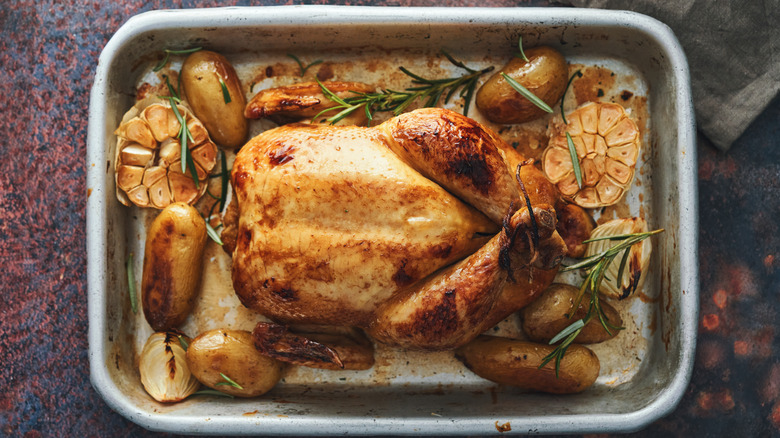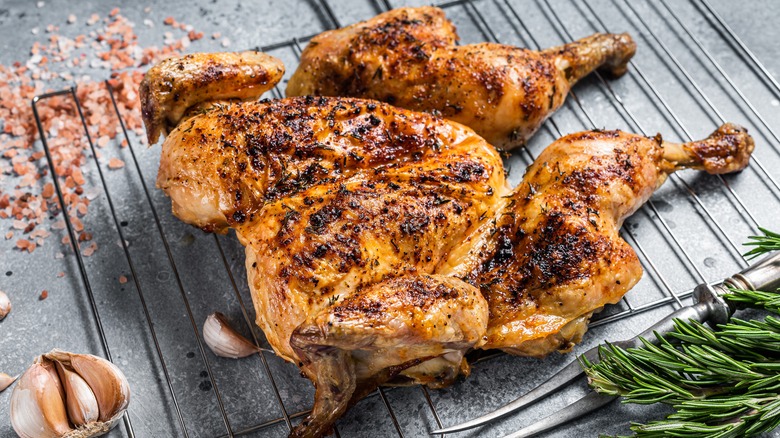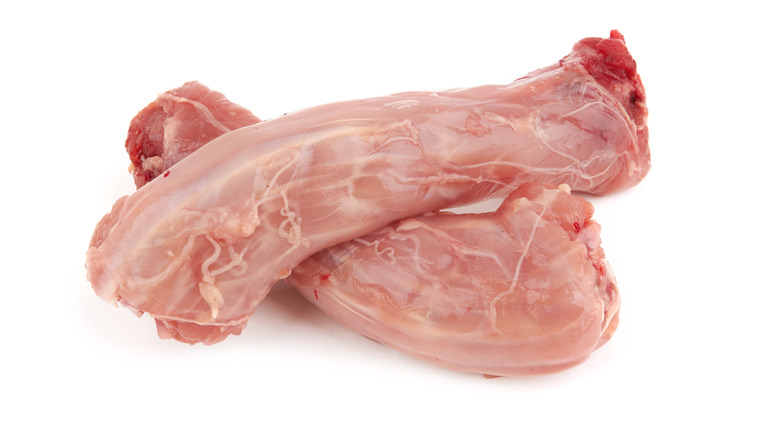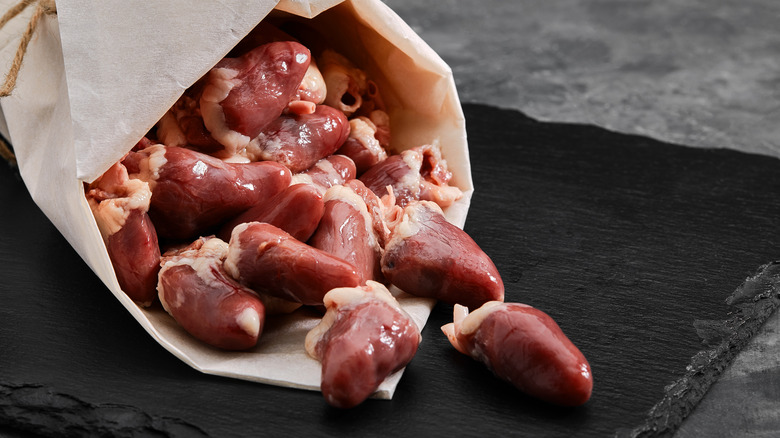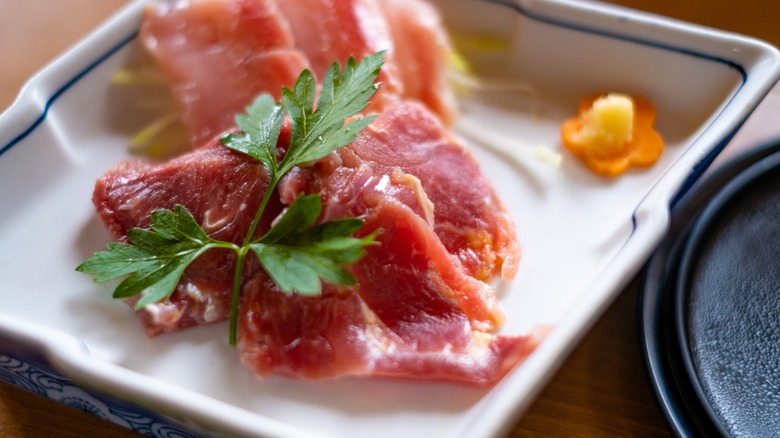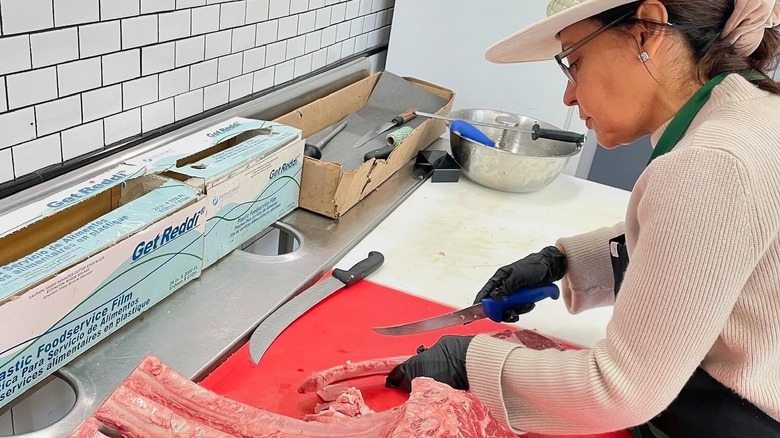7 Cuts Of Chicken To Buy And 5 To Think Twice About, According To A Butcher
"Tastes like chicken" takes on a whole new meaning when you've sourced the best possible cut for your dish. But, between the white meat, the thighs, and the giblets, how do you know which part to buy (and which one to skip)? Well, you ask an expert. Luckily, we've tapped the perfect butcher for the job.
Rosangela Teodora, owner of Teodora's Boucherie Gourmande just outside of Boston, Massachusetts, is a third-generation butcher who grew up learning the tricks of the trade on her dad's cattle ranch in Brazil. These days, she keeps the family legacy alive through her continued commitment to ethically raised animals, personal relationships with local purveyors, and deliciously nourishing food. Plus, along with carving out a hefty tomahawk steak, she knows a thing or two about how to break down a chicken.
From their heads to their three little toes, Teodora takes us on a wild ride through the chickenverse, steering us toward versatile cuts and opening up the door to new favorites. Are you about to become a total fan of chicken necks? Will you legally make "Spatchcock" your middle name? And is Japanese chicken sashimi coming to the States? Fire up the deep fryer; we're going all in on chicken parts.
Go for the whole chicken
We daydream of casually walking in the door, placing a fresh baguette and flowers on the counter, and effortlessly cooking Ina Garten's simple roast chicken while drinking a martini and swaying to jazz on vinyl. We're not 100% on the music, but the chicken part is totally doable.
First, find your bird. Teodora tells us what to look for, recommending, "Fresh chicken should have a pinkish hue. Avoid gray or transparency. A clean, neutral aroma is also a good indicator of freshness." You can find whole chickens in just about any grocery store, but for the purest, most vibrant flavor, stop by your local butcher.
As far as the prep goes, there's a new trend in town, and it looks like a chicken that didn't quite make it across the road to get to the other side. "Spatchcock chicken has gained popularity recently due to its benefits, which include a faster cooking time," Teodora says. With its backbone removed, the chicken lays flat, with the butcher noting, "Spatchcock chicken cooks more evenly and quickly, making it ideal for busy home cooks." Pointing to its extra-crispy skin and touting it as a great option for the grill with its customizable seasoning profile, Teodora calls it a winner for any chicken dinner. "The flattened shape of spatchcock chicken makes an impressive presentation, perfect for special occasions or social media sharing nowadays." We have no idea what she's talking about. (#Wink.)
Snag those chicken tenders
It appears that 5-year-olds everywhere had it right all along; chicken tenders are indeed the best meat on the bird. Rosangela Teodora also enjoys using this cut, adding, "They are tender enough to do anything with and [have] less fat." Pass the barbecue sauce.
But if we're looking for juicy flavor, why would we choose the boneless white meat from just under the chicken breast? It turns out we no longer need bones to impart moisture into cooked chicken. "The air fryer and the pressure cooker have revolutionized the many ways that a cook can prepare a protein without any effort," Teodora says. Versatility is another winning feature of the chicken tender life, with the butcher adding, "Put [it] in a rice cooker, pressure cooker, or add any sauce in your pantry, and you have a brand new meal."
You'll also find this cut listed under French goujons, strips, and chicken filets. (Or "tendies," depending on your level of coolness.) You can remove any visible tendons from your tendies with the fork tine hack, for the most succulent chicken tenders ever.
Keep it classic with chicken breast
Cook up a classic with this lean, white meat cut from the pectoral muscle of the chicken; the breast. While it might seem like the "Intro to Chicken" option, chicken breast was born for weeknight dinners.
"The classic Italian chicken piccata is a forever recipe that you can always count on in a pinch or if you want to impress someone with your cooking skills," suggests Teodora. (Um, yes, we do. Tell us everything.) "You can use thinly sliced chicken breasts, pounded to an even thickness. (...) Dredge the chicken in flour, then sauté in butter or olive oil until golden brown. Add a squeeze of fresh lemon juice, a sprinkle of capers, and a splash of white wine (optional). Serve with a side of pasta, risotto, or roasted vegetables."
Proving that it is, in fact, possible to cook chicken breast in a way that doesn't leave you high and very, very dry — as far as the meat goes — Teodora explains, "The thinly sliced chicken breasts allow for a crispy exterior and a tender interior, while the tangy lemon and capers add a bright, savory flavor."
The bonus buy of chicken skin
One of the trendier cuts of the bird, chicken skin appears to have found new life as a crispy, chip-like version of its formerly flabby self. "Yes, [it's] very, very delicious," Teodora notes. "You can use [it] on top of salads and soups or eaten by itself as a snack." And it's all thanks to something called schmaltz.
"Rendering chicken fat is a thing and it is called [schmaltz], inspired by Arthur Schwartz, who is renowned for Jewish home cooking," Teodora explains. After chicken fat is cooked down with water, it then subs in for extra virgin olive oil or butter. Serving as the original umami flavor-maker in early Jewish households in Central and Eastern Europe, this "liquid gold" went out of fashion as communities went non-kosher. Cookbook author Arthur Schwartz helped modernize this old-world cooking technique for contemporary kitchens. As Teodora notes, it's "a staple in traditional Ashkenazi Jewish cooking. They use it [to] make chopped liver, matzo balls, and other types of dishes."
Schmaltz then hits the snack aisle with a few extra steps. Teodora says, "If you strain [schmaltz], you get a very crispy skin as thin as an onion that can [be] eaten as a snack or used on top of the salads and soups. It is like pork skin." You'll also see chicken fried skin on the shelves. Move over, BLT sandwiches. We're all about the CLT with chicken skin that's so crispy, you won't miss the bacon.
Chicken thighs pack a ton of flavor
It seems that all the flavor of the chicken went straight to its thighs. Known for featuring tons of tender, meaty tastiness in a dark meat package, chicken thighs can be found at the top of the legs.
Despite the fact that this cut can star in just about any dish you could think of, it's still a good idea to look for the freshest chicken you can find. Teodora advises, "Chicken should be plump when you press it. The meat should be somewhat resilient, resuming its shape after a few seconds." Even though the thigh is a fattier cut than, say, the breast meat, it's still worth poking around a little bit before you buy.
You might even find thighs packaged as ground chicken meat — which is probably more likely at a butcher shop. Teodora notes, "Ground chicken is minced chicken parts, both dark and white meat, and skin. I like only grinding the thighs so it is moist." As far as what to do with ground chicken thighs, we're seeing thigh-forward meatballs in our future. You can even grind the thighs yourself. Teodora encourages, "Any cooking skill [level] can do it with minimal error."
Chicken drumsticks serve up satisfying texture
Moving on down the chicken leg, Teodora also recommends buying drumsticks when you find them. This cut comes from below the thighs, and features a crowd-pleasing, firm bite. This richly-flavored dark meat cut is almost always found with the skin on, too. It's the perfect part of the bird to use for double-fried — and breading-free — Korean fried chicken.
As we learn about which parts of the chicken to buy, it's also key to know what to look for on the packaging (or ask about at the butcher shop). Teodora recommends meat that has been "raised without antibiotics" and is "Non-GMO Project Verified." She says these markers reveal the story beyond the labeling, adding, "Make sure the chickens were never administered antibiotics at any point. Of course (...) farmers would not administer antibiotics unless necessary, but make sure you receive a very resilient chicken that was treated with ethics, compassion, [and was] happy and healthy its whole life."
By now, we're all well aware of buying non-GMO (food that's free of genetic engineering or supplements that don't occur in nature), but what about our food's food? Teodora reminds us that corn is almost always genetically modified, and that many chickens eat it in their diet. She says, "This seal (non-GMO Project) appears on chicken that [was] raised and fed on a sometimes certified organic, certified non-GMO diet that's in compliance with Non-GMO Project standards. This represents a clean chain of standards from farm to customer."
Fry up a batch of chicken wings
You know this one already. If you're frying, baking, smoking, or air-crisping, chicken wings are where it's at. Teodora notes, "The most classic and common chicken cut for frying is the breast because [it's] lean and tender. Followed by tenders and the wings."
For reference, the National Purchase Dairy group reported that we chowed down on a whopping 1 billion orders of chicken wings in 2019. (So many buffaloes lost their lives for those wings.) Still, even though wings are typically smaller, bone-heavy, and slim on the delicious meat (hello, we came for the chipotle ranch sauce!), it's still a good idea to buy the best chicken you can find.
"It is hard, to impossible, to find good chicken meat," Teodora explains, comparing the differences between craft butcher shops and big industry chicken. Noting that name brands have the resources — and the directive — to preserve the meat for longer periods of time, she adds, "But there is nothing comparable to a slow-raised chicken who spends its entire life outdoors, living its life followed by a butcher on site. This type of chicken is by far the best. (...) The difference is exceptional taste and quality."
The fiddly nature of chicken necks
We have reached the echelon of chicken parts and curiosities — and for this, we rely on a standard American taste profile. (Like the one on TV.) While the chicken neck may be a ceremonial dish in some cultures — you might find it on a Seder plate — it has yet to make it big in the U.S.
Even so, Teodora shares, "For me, the most underrated part of the chicken is the chicken neck. It is like eating lobster legs and similar [in] that it takes a little effort to get to the tender and flavorful meat hidden between the little bones." Wait, we heard "lobster" — we're back on the chicken neck train.
With their rich, tender, and slightly gamey flavor profile, Teodora explains that chicken necks make for wonderful broth and slow-simmered stocks. "Chicken necks are packed with flavor and collagen, which makes them perfect for slow-cooking methods like braising or stewing." She also claims that enjoying the process of hunting down the meaty morsels is all part of the fun when it comes to chicken necks. She says, "It will take time to eat the meat between the little bones, but it is satisfying to eat bit by bit."
Chicken feet await a Stateside splash
When it comes to the typical American palate and its relationship with chicken feet, Teodora says, "People do not enjoy eating these parts." China tops everyone else in the world when it comes to enjoying chicken feet. And almost no one will bat an eye if you serve chicken feet (or "chicken paws") in Africa or the Caribbean. So why is the U.S. slow to adapt this dish?
If they look like they have no meat on them, chicken feet would also agree. They're mostly comprised of tendons, bones, and skin, with the cooking method and particular seasoning adding the tasty flavor. But despite their relative show-stopping quality in the States, there seems to be an opening if you want to spice up a dinner party. As far as possibly listing chicken feet as your contribution to the next pot-luck, Teodora jokes, "If you want to bring chicken feet, add a French name to it, and someone will eat [it]." Chicken foot fricassée, here we come.
Wanna give chicken feet a spin? Spicy Filipino chicken Adidas (because these are chicken feet with a little sporty style) just might get your foot in the door.
The chicken heart and liver can be difficult to cook
Another polarizing cultural dish, chicken organs like the heart and liver — commonly referred to collectively as gizzards or giblets — are probably either the best thing you've ever tasted, or the worst thing in the world. Either way, they require a little more effort to cook than your standard chicken tendies.
"Gizzards are a unique delicacy in many cultures," Teodora shares. "They are packed with texture and flavor, high in protein, and low in fat, making them a nutritious option. They can be grilled, sautéed, or used in soups and stews." You'll find them done up with teriyaki sauce, curried and skewered, served over rice, tossed with mushrooms and fresh herbs, or simmered in savory gravy. Grilling brings out their mildly gamey, slightly metallic flavor. But of course, you're probably putting sauce on that.
Still, that low-key flavor profile is what makes these chicken bits a wonderful base for many recipes. "Gizzards are often overlooked in favor of more popular cuts, but they offer a lot of flavor and versatility to dishes," Teodora shares.
The secret sauce of chicken blood
For the record, this isn't about any kind of magic potion we're cooking up in the forest. Chicken blood may be the reason for all of the flavor you find in dark meat, versus leaner white meat, but when it comes to the hemoglobin itself, we have varying feelings on the matter.
First off, animal blood features heavily in culinary dishes around the world. Black pudding or blood sausage is commonly eaten in Europe and Latin America, and blood tofu is popular in China. It's a primal thing to think about draining the blood of your own chicken, but that blood can then be used to season dishes and thicken sauces. But, even though it's packed with protein, we think we'd rather let someone else do the work of harnessing this element of the chicken.
Still, leave it to a seasoned pro to know what to do with the leftover blood from fresh chicken gizzards. Teodora explains, "Collect the blood in a glass and let it firm up a little. Put it in your rice cooker and cook it in a little corner of the pan. You will end up with something like the liver in taste and shape."
Skip the raw chicken stuff
In American culture, we're all about the safest measures for handling raw chicken in our own kitchens. But it's a different story in Osaka, Japan, where meticulously prepared chicken sashimi is the complete meal — and yes, it really is raw.
"Torisashi (...) is a controversial delicacy that is deeply rooted in traditional food culture and wisdom. However, it is [a] risky dish to eat," Teodora warns, citing USDA guidelines on U.S. food safety that leave no room for even slightly undercooked chicken. Sliced from the inner breast, a seconds-long flash-boiled preparation isn't nearly enough to eliminate the possible presence of bacteria. She adds, "The chefs that prepare it follow precise methods to minimize the risk of contamination, including using high-quality chicken, [and] handling and storing in low temps." But it's still not enough to tempt this former rancher. "I'll pass."
Unless campylobacter and salmonella sound like a nice garnish, maybe leave the raw stuff to the chefs in Japan. They may be operating under the highest standards in Osaka, but this dish might need a little longer in the oven to be accepted in the States.
Why a butcher knows best when it comes to meat
It almost seems that Rosangela Teodora can read our minds when she talks about her typical client. "Customers today follow recipes from books or do whatever they see on Instagram," she says, also happy to help them navigate a recipe from the internet. "You can always substitute for another chicken part."
Explaining that most modern butchers take pride in being knowledgeable about the entire lifespan of their animals, she hopes to pass that care and craftsmanship onto her regulars. "It is a process and requires a lot of customer education to return back to the old-school, trusted craft of butchering," she explains. "Unfortunately, that trusted relationship has been [harmed] by grocery stores who encourage grab-and-go meat with no intention, quality or service."
Still, despite the downsides to mass-produced meat, there's a glimmer of hope at smaller, local outposts. Teodora assures us, "At my butcher shop, you can get high quality, time, and service while you shop." Now that we've got our favorite cuts of chicken unlocked, we just have to figure out how to properly cook these beautiful birds.

